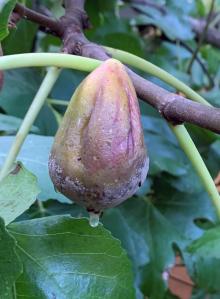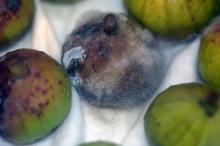Cause The fungus Botrytis sp. has been reported in Washington and found by the OSU Plant Clinic. Alternaria alternata has been a problem on ripe fruit in California. Rain or dew when figs are ripening will result in surface spotting. These spots are up to 0.2 inch in diameter, are light-brown to-black in color, sunken, and distributed over the entire surface of the fruit. Many of these fungi can be found in the environment, on fruit surfaces, and can colonize damaged tissue.
Surface mold caused by Cladosporium herbarum occurs in California on both green and ripe fruit, but tends to be more common on green fruit. The lesions usually occur in areas of fruit contact.
Symptoms Botrytis fruit rot is first seen as water-soaked area on the fruit. Fruit begin to wilt and collapse followed by the production of masses of closely appressed, buff-colored spores in the necrotic areas.
Surface mold is initially seen as small, olive-green specks but as they enlarge the infected area turns yellowish olive and becomes sunken.
Alternaria fruit rot - water-soaked areas develop on the surface where two or three figs touch but lesions are soon covered with dark green spores.
Cultural control
- Harvest fruit before it is overripe and/or before rainfall events.
Reference Michailides, T. J., and Ferguson, L. 2009. Alternaria Rot. In UC IPM Pest Management Guidelines: Fig. UC ANR Publication 3447. https://www2.ipm.ucanr.edu/agriculture/fig/Alternaria-Rot/



